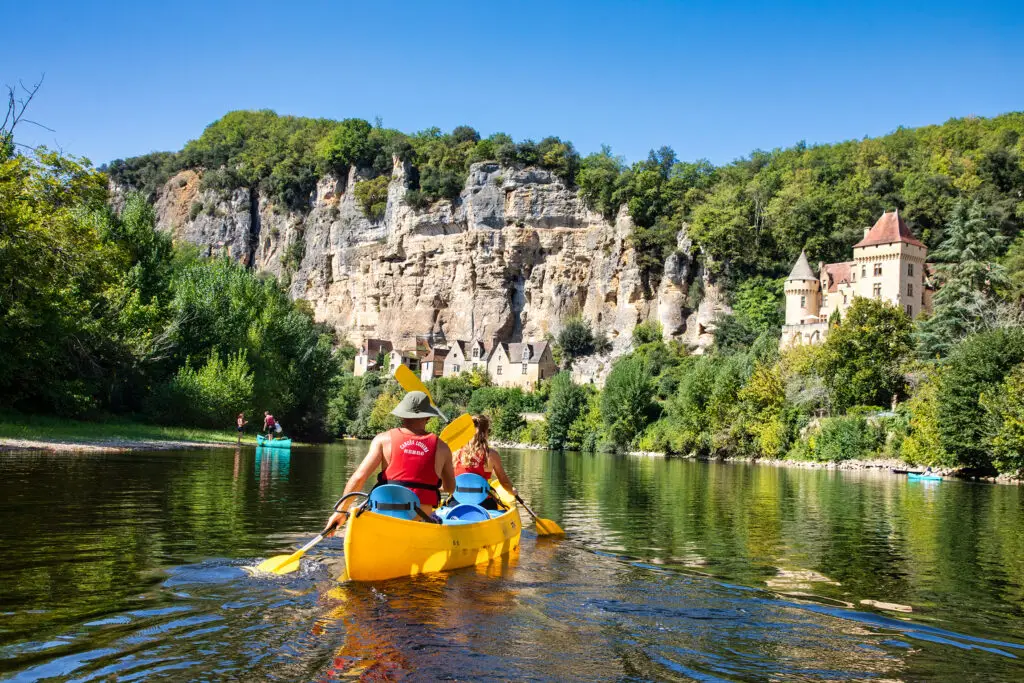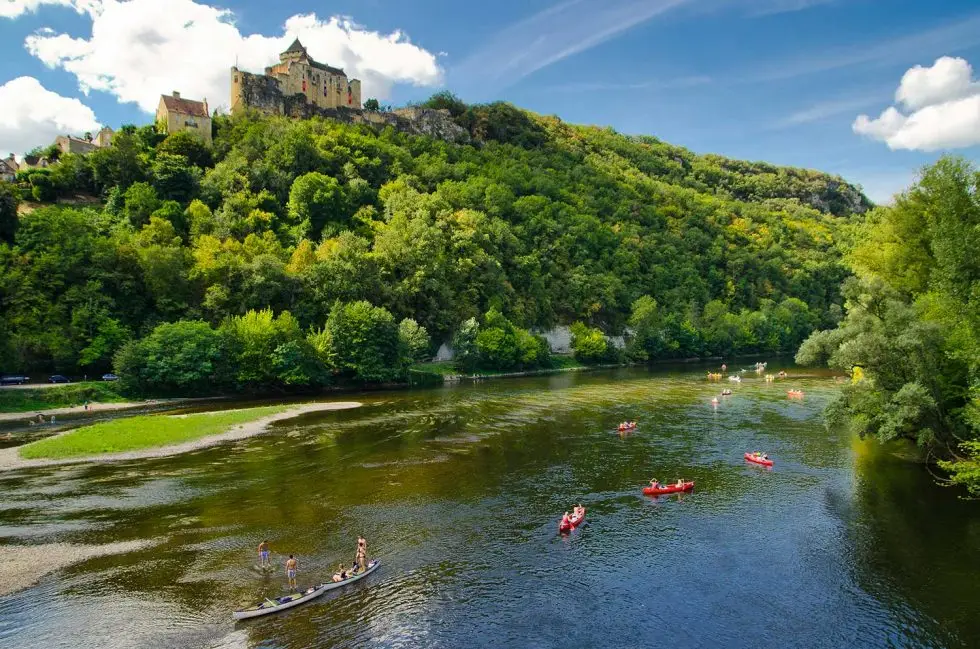


Canoe course
Vitrac Castelnaud

The port of Vitrac, whose peyrat (port) can be imagined, reveals another history through its hotel activity: that of the Gabares. With the development of the wine trade to England during the Capetian-Plantagenet war, the need for wood to make barrels continued to grow. Boats soon began transporting this wood, creating a major trade route between the Auvergne and the Gironde.
These barges carried stavewood (chestnut planks used to make barrels) and carrassonne (chestnut stakes used to grow vines). Depending on where they came from, barges had different destinies. Coming from the upper Dordogne, they were dismantled and sold like the wood they carried. Coming from the Souillac area, they were loaded mainly with salt and hauled up the river by oxen along a towpath. The return journey was punctuated by stops at various ports, where the Gabariers traded and dined. Vitrac was one of these ports.

Pass under the left arch of the bridge. You now skirt a small islet, a nature reserve for birds (disembarking prohibited), before finding a branch of the Dordogne on your right. The river now begins a second curve to the left. On the right bank, you'll discover a cave, another river surveillance point. Now's the time to talk a little history: the river was an essential control point, and strategic positions were quickly fortified during the Hundred Years' War. In 1152, Eleanor of Aquitaine, ex-wife of Louis VII, offered Aquitaine to Henry of Plantagenet (a fine gift!). This marked the start of two centuries of hostilities, during which the Bastide of Domme played an important role (built in 1282 by order of Philippe le Bel).
Leaving the Beau Rivage campsite on your right, take the left-hand branch of the river which leads you gently around a wide bend to the right, then the long straight stretch to the steep promontory of DOMME and its belvedere.

You are now at the CÉNAC level. This is the former port of DOMME, which explains the presence of mooring rings fixed to the bridge. Just beyond this, on the left bank, behind a small islet, you'll see the Cénac embarkation beach.
A little further on, the water accelerates for a hundred meters or so, at the passage des Pendoils. Several blocks of basalt emerge from the surface (don't worry, it's harmless), most likely the remains of a Roman legion crossing point at low water levels.
You are now facing an imposing limestone cliff, a favorite haunt of buzzards, kites and peregrine falcons. If you look up, you can sometimes witness battles between birds of prey during the nesting season.

You're approaching the village of La Roque Gageac, one of France's most beautiful villages. A little history?... We were in the Hundred Years' War! Come on, let's take a step back into prehistory... Flint knapping found here suggests that La Roque Gageac's occupation dates back to one of the prehistoric periods. The staircase against the cliff? Quite simply, it's the remains of La Roque's fortress, built to protect against Viking invasions. Later, an enclosure with fortified houses was added and served as a refuge for the bishops of Sarlat, to protect themselves from successive raids.
The city was reputed to be impregnable. It was a major port and trading center during the era of inland waterway transport (gabares), before being replaced by animal-drawn towage in 1817. The village has all services. You now leave La Roque Gageac, passing the Château de la Malartrie (maladerie in medieval Occitan) on your right, then the beach and municipal campsite. Built between the 10th and 12th centuries as a hospital for contagious diseases, the château was abandoned until it was bought by an industrialist in 1902. He wanted to restore it in Renaissance style, a style that was not fully respected! Today, the château is home to a family of illustrious Périgord diplomats.

Contemplate the Château de la Malartrie from your canoe! Nestling on the banks of the Dordogne, this château offers a majestic view from the water. Paddle peacefully while admiring its elegant architecture and enchanting natural surroundings.

At the CASTELNAUD bridge, if this is your destination, turn left to stop just after the bridge without getting caught in the current continuing towards Beynac...
Castelnaud castle (12th century), which over the centuries was sometimes English, sometimes French, depending on the successive sieges, offers an incomparable view over the Dordogne and was the object of envy of the lords of Beynac. It eventually belonged to François de Caumont, who considered it too austere and had the Château des Milandes built.
